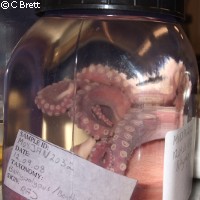Diving for drugs in the Arctic
Norwegian researchers are diving into the icy depths of the Arctic Ocean in a hunt for new compounds that could be turned into drugs. These drugs could help to treat a wide range of diseases and conditions, including bacterial infections, cancer and diabetes. Bioprospecting (defined as the search for interesting and unique genes, molecules and organisms with features that may be of value for commercial development) is nothing new; intrepid researchers have been searching for medically active compounds in rainforests for decades, and over 60% of the almost 900 new chemical entities that reached the market in the last 20 years were originally found in nature. Until now, most bioprospecting activity has been taking place on land. However, the number of new compounds found in terrestrial ecosystems is now tailing off, and so the bioprospecting research community is turning its attention to an (as yet) largely untapped resource: the oceans. 'There are millions of bacteria in one litre of sea water, so there's a huge potential,' explained Dr Jeanette Andersen, a Research Manager at MARBIO, a marine bioprospecting research centre based at the University of Tromsø in northern Norway. 'Now the marine environment is easier to access, there is a whole new pool of molecules you can fish from.' An example of a drug with marine origins is the painkiller Prialt. In nature, the active compound in this drug is produced by the magician's cone snail (Conus magus), which uses it to paralyse fish. In the clinic, the same compound is used to treat chronic pain. The team in Tromsø is focussing its efforts on species living in the seas around the Arctic. 'We think the Arctic is quite unique,' commented Dr Andersen. Species living in the region have developed a range of physiological and biochemical tricks to survive in the harsh Arctic environment and the scientists hope that some of these could have useful applications in the clinic. Scientists from a range of disciplines as well as SMEs (small and medium-sized enterprises) active in the drug development sector are working together to screen Arctic marine organisms for useful compounds and hopefully develop exciting new drugs. The first stage of the process entails collecting the samples; fortunately, the scientists have access to a research ship. Each sample is logged and tagged with information on the species and the environmental conditions at the site where the sample was taken; this is important as the same species may produce different compounds at different temperatures, for example. Back in the lab, larger organisms are dissected so that individual organisms can be analysed separately. The researchers now have samples from some 500 organisms, mostly invertebrates, stored in freezers and jars in their labs. The samples are subjected to a barrage of tests to find out if they contain compounds which could have antioxidant properties or be used to fight cancerous tumours, tackle bacterial infections, reduce inflammation or improve blood sugar regulation in diabetics. Samples are purified and re-tested until any potentially interesting compounds have been isolated; currently, the scientists have some 200 such compounds in their database. Most of these are probably not new to science, although as Dr Andersen pointed out, finding known molecules is not necessarily a bad thing. Firstly, it proves that MARBIO's screening procedures work well, and secondly, they could find a new use for a known molecule. Many bioprospectors only screen their samples for one or two properties, whereas MARBIO screens for many more. The next stage of the process involves zooming in on these interesting compounds and determining their structure, properties and mode of action. This stage is extremely time-consuming and a major challenge for the researchers is deciding which molecules to prioritise for this work. Currently, the team has nine compounds at this research stage, although for commercial reasons Dr Andersen was unable to say more about them. Meanwhile, the team is collaborating with a Russian research institute in Murmansk, which will afford greater access to species living in the Barents Sea off the north coast of Russia. The researchers are also involved in a consortium which is applying for funding from the EU's Seventh Framework Programme (FP7). Dr Andersen is optimistic about the future. 'We really think that we will have lots of new molecules, not only for drugs but for diagnostic purposes too,' she said enthusiastically. 'Some could also be used in functional foods.'
Countries
Norway



